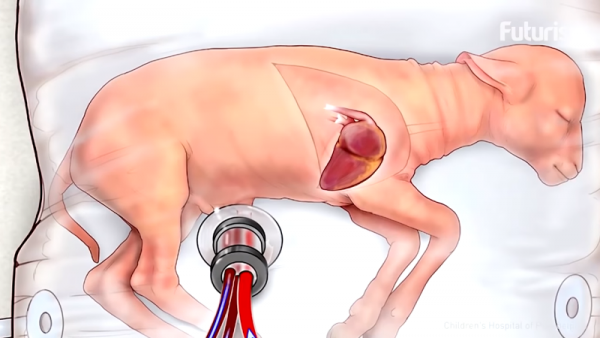By KM Diaz, | April 26, 2017

The artificial womb is a bridge between the outside world and the womb of the mother to carry the infant from 23 to 28 weeks of gestational age. (YouTube)
Researchers have developed an artificial womb that could possibly reduce the mortality of premature babies.
According to the researchers from Children's Hospital of Philadelphia, the external artificial womb recreates the condition required for the normal gestational development of premature lambs. The lambs developed inside the fluid-filled device which sustained them for four weeks. After the incubation period, the researchers were able to observe the improvement of the lamb's lungs, brain, as well as its vital organs.
Like Us on Facebook
One of the leading causes of infant death and disease is extreme prematurity. Approximately 30,000 babies are born before the 26 weeks of gestation in the United States every year. The condition also causes half of all cerebral palsy diagnoses and a third for all infant deaths.
The current treatment for premature babies is placing them in an incubator to monitor the development of their body. Emily Partridge, the co-author of the study, explains that conventional care supports organ functions, mechanical respirations, gas based ventilation of lungs, and intubation.
But, the treatment could also harm the health of premature babies because the gas-based methods damage the lung development that may lead to lifelong health issues. The treatment could also expose babies to infectious pathogens.
The artificial womb could revolutionize this approach by simulating the condition inside the mother's womb. In the experiment, Alan Flake, the lead author of the study, together with his colleagues worked on a semi-closed, fluid-filled artificial environment made up of polyethylene bio bag to be used as the umbilical cord of the infant lambs to build the oxygen circuit. Lambs were used in the experiment because their prenatal lung development is similar to human.
After the C-section, six premature fetal lambs were transferred in a plastic container. They grew normally in the device container, which is a near-sterile and temperature-controlled environment. Their hearts pumped blood through umbilical cords, and then towards a gas exchange system outside the bag and breathed in amniotic fluid. An electronic monitor observed their blood flows and vital organs.
Compared to previous studies, the artificial womb does not require an external pump to drive circulation since the fetus gives all of the power. This is crucial because even a gentle pressure could damage the underdeveloped heart.
Moreover, the artificial womb does not need a ventilator because the heart of the baby pumps itself towards the umbilical cord and then into the low-resistance external oxygenator of the system to substitute the placenta of the mother. The artificial amniotic fluid, on the other hand, simulates the condition of the fluid filled sac of the mother to let the lungs and vital organs to naturally develop.
Most importantly, the artificial womb is not meant to prolong viability outside the womb or to bring a baby to full term, it is meant to use as a bridge between the outside world and the womb of the mother to carry the infant from 23 to 28 weeks of gestational age. Some scientists also believed that artificial womb could sustain the fetus externally from conception until full term birth.
However, the research team said that further study is needed before testing the system to human infants, like reducing the size of artificial womb because human fetuses are smaller than lambs. Furthermore, Flake said that when the artificial womb is ready to use for premature human babies, it will have a chamber filled with amniotic fluid. Similar to the mother's womb, it is also closed from the outside world. The baby will only be monitored through a dark-vision camera placed inside the system.
-
Use of Coronavirus Pandemic Drones Raises Privacy Concerns: Drones Spread Fear, Local Officials Say

-
Coronavirus Hampers The Delivery Of Lockheed Martin F-35 Stealth Fighters For 2020

-
Instagram Speeds Up Plans to Add Account Memorialization Feature Due to COVID-19 Deaths

-
NASA: Perseverance Plans to Bring 'Mars Rock' to Earth in 2031

-
600 Dead And 3,000 In The Hospital as Iranians Believed Drinking High-Concentrations of Alcohol Can Cure The Coronavirus

-
600 Dead And 3,000 In The Hospital as Iranians Believed Drinking High-Concentrations of Alcohol Can Cure The Coronavirus

-
COVID-19: Doctors, Nurses Use Virtual Reality to Learn New Skills in Treating Coronavirus Patients












